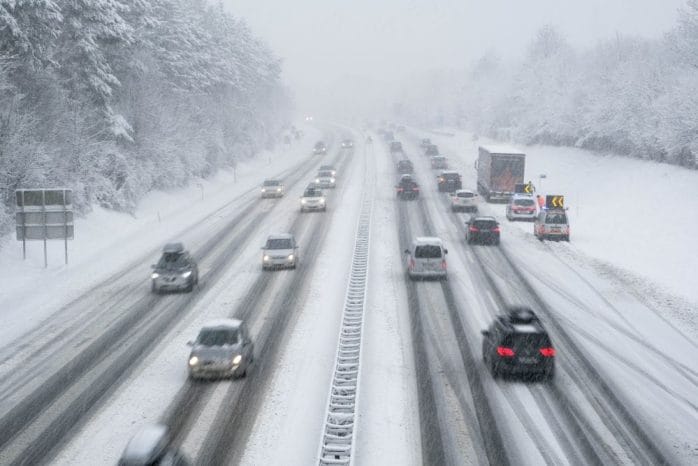Winter Weather Preparedness with Climavision Radar
The 2025–2026 winter season is fast approaching, and for utilities and departments of transportation (DOTs), the need for precise and timely weather information has never been greater. Every year, severe snow and ice events challenge grid stability, transportation safety, and emergency response coordination. In fact, since 1980, the average annual economic cost from severe winter weather is nearly $2.5 billion. However, according to a new economic study by Allstate, the U.S. Chamber of Commerce, and the U.S. Chamber of Commerce Foundation, every $1 of upfront investment reduces the damage and cleanup costs of a natural disaster by $6.
The difference between a proactive response and a costly disruption often comes down to visibility — literally. Seeing the weather as it develops and at the surface where impacts occur, is critical. That’s where Climavision’s high-resolution, gap-filling radar network is transforming winter preparedness and response.

In Summary
- Climavision’s gap-filling radar network provides low-level visibility where NEXRAD coverage is limited which is crucial for detecting snow squalls, freezing rain, and lake-effect snow that threaten grid reliability and public safety.
- During the January 2024 southeastern Pennsylvania snow squalls, Climavision’s Millersville radar enabled earlier warnings and improved response, preventing dangerous “surprise” whiteout conditions.
- In the November 2024 Erie lake-effect snowstorm, Climavision’s Pleasantville radar captured record-breaking snowfall missed by nearby NEXRAD sites, helping local media and emergency managers guide residents safely.
- Utilities and DOTs, benefit from real-time, high-resolution radar data that improves hazard detection, power restoration readiness, and infrastructure resilience.
- With continued network expansion and pairing with Horizon AI forecasting models, Climavision is equipping agencies with complete situational awareness.
Seeing What Others Missed — The Importance of Gap-Filling Radar
The National Weather Service’s NEXRAD network provides vital weather surveillance, but its coverage isn’t perfect. Many regions across the country, especially in complex terrain or between radar sites, experience significant “gaps” in low-level visibility. These blind spots make it difficult to detect shallow snow squalls, freezing rain bands, or lake-effect snow — events that can rapidly escalate into dangerous situations.
Climavision’s proprietary X-band radars fill those gaps. Each system provides high-resolution coverage within a 60-mile radius, offering an unparalleled look at precipitation patterns close to the ground. This level of visibility enables earlier warnings, better coordination, and more informed decision-making when seconds matter.
The past winter offered powerful proof of how supplemental radar coverage can improve safety and operations.
Case Study: Southeastern Pennsylvania Snow Squalls (January 2024)
In January 2024, fast-moving snow squalls developed across southeastern Pennsylvania, producing near whiteout conditions and sudden travel hazards. Thanks to Climavision’s PA108 radar in Millersville, forecasters and emergency managers could see what traditional systems missed.
The nearest NEXRAD radar, located nearly 90 miles away, overshot the low-level squalls, leaving critical areas effectively unseen. Climavision’s radar, however, detected and tracked these intense snow bands as they raced eastward.
The Millersville University Weather Center highlighted the impact of this coverage, noting that the “new X-band radar at @millersvilleu was undoubtedly of great assistance to the @NWSStateCollege and @NWS_MountHolly in issuing Snow Squall Warnings yesterday.”
For Pennsylvania DOT and regional emergency managers, this visibility means:
- More lead time for road pretreatment and snowplow dispatching
- Earlier traveler alerts for highway corridors
- Fewer “surprise” squalls that endanger motorists and responders
By closing one critical radar gap, Climavision directly supports public safety and response efficiency.
Case Study: Erie, Pennsylvania Lake-Effect Snow (November 2024)
Just after Thanksgiving 2024, a powerful lake-effect snow event swept through the Great Lakes region. Erie, Pennsylvania, was hit hardest — recording 22.6 inches of snow in a single day and over 42 inches total by the end of the weekend.
Climavision’s PA109 radar in Pleasantville filled a long-standing blind spot for the region. The nearest NEXRAD sites in Buffalo, Cleveland, and Pittsburgh all overshot low-level precipitation bands, missing much of the heavy snow that snarled travel and shut down I-90.
Climavision’s radar captured the structure and intensity of the snowfall in remarkable detail, giving agencies a clear picture of where impacts were most severe and providing accurate snowfall totals. Even local media used the data in real time — WICU in Erie broadcast Climavision radar imagery live, helping viewers and motorists better understand conditions and avoid danger.
For utilities and local authorities, this enhanced visibility meant improved power restoration readiness and more accurate hazard mapping in one of the season’s most disruptive events.
Strengthening Winter Preparedness with Better Data
For public agencies and critical infrastructure operators, accurate radar data is more than a forecasting advantage — it’s an operational necessity. High-resolution, real-time weather intelligence supports:
- Proactive hazard response: Better visibility of freezing rain, ice, and snow band formation
- Grid reliability: Improved situational awareness for crews and load managers
- Transportation safety: Faster decision-making for highway, bridge, and transit operations
- Flood and runoff management: Early detection of snowmelt or rainfall contributing to flash flooding
Through its Radar-as-a-Service (RaaS) model, Climavision enables public and private entities to gain access to or host radar coverage in high-risk regions, improving community resilience and operational reliability without major infrastructure investment.
Looking Ahead — Building on Proven Winter Performance
Building on last winter’s success, Climavision continues expanding its radar network across the United States, closing more of the nation’s most critical radar gaps. These installations are also paired with Climavision’s suite of Horizon AI forecasting models, including Horizon AI HIRES for short-term precision and Horizon AI Point for site-specific operational forecasts.
Together, these tools give agencies and utilities complete situational awareness — from nowcasting through long-range planning.
Ready to strengthen your winter preparedness strategy?
Contact us today to learn how Climavision’s radar and forecasting solutions can enhance your visibility, response, and safety this winter.





